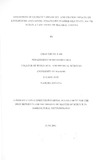| dc.description.abstract | Climate variability and change have serious environmental, economic, and social impacts on
South Sudan in particular, where livelihoods of large populations depend on rain fed
agriculture. Drought and flood are the major climatic factors affecting crop productivity in
Malakal County. In addition, information related to weather such as seasonal forecast is
hardly exists. Farmers in this area are expected to be more vulnerable since they used only
their traditional knowledge and skills to forecast onset of seasonal rainfall and when to plant
and decide which crop is suitable to be cultivated. This study was therefore conducted to
address issues related to climate variability and change impact faced by farming community.
The overall objective of this study was to assess the impacts of climate variability and change
on livelihood based on agriculture in Malakal County South Sudan.
Long term daily (1973-2002) and monthly rainfall (1963-2010) data as well as space-borne
remote sensing data were used to study variations in climate over Malakal County. The daily
data were used to assess wet and dry spells during critical crop growing period. The monthly
time series of NDVI and rainfall from 1982-2008 for Malakal were plotted. The study also
investigated the impacts of climate change and variability on crop productivity taking
farmers' perception and expenence into account. This was done through randomized
selection of 200 sample size of farmers whose farm was between one and two hectares and
had been cultivating for at least 10 years. Vulnerability assessment of climate-related impacts
on crop yields, coping mechanisms and resilience levels of farmer communities was also
examined.
The study indicated that the probability of occurrence of 5 days dry spells was as high as
73%. Crop failure during growing season, incidences of pest and diseases and food shortage
were some of the major impacts reported by the farmers. On average most of the rainfall
occurred between June and October, with a maximum in August. The most vulnerable
population to climate change and variability are farmers with few resources to assist cope
with extreme weather conditions like drought, floods, erosion and diseases. Farmers reported
different methods of coping with the negative impacts of climate variability and change that
include, selling cattle, charcoal burning, fishing and sending some members of their
household to urban area to look for jobs to earn extra incomes. | en |

